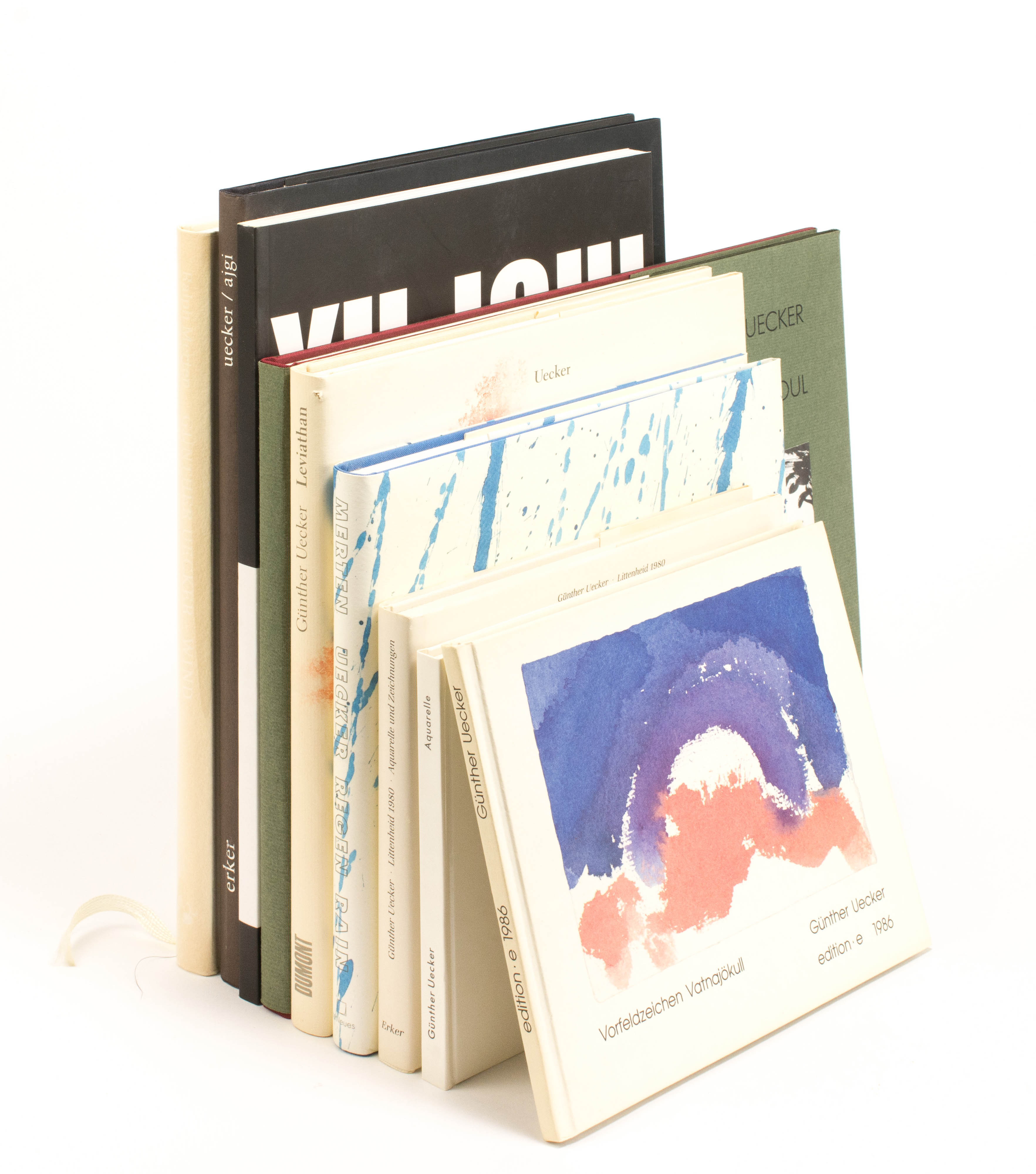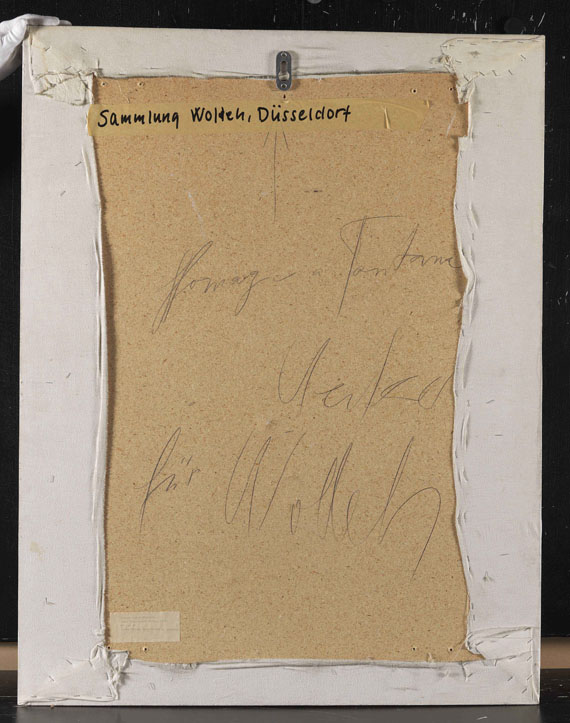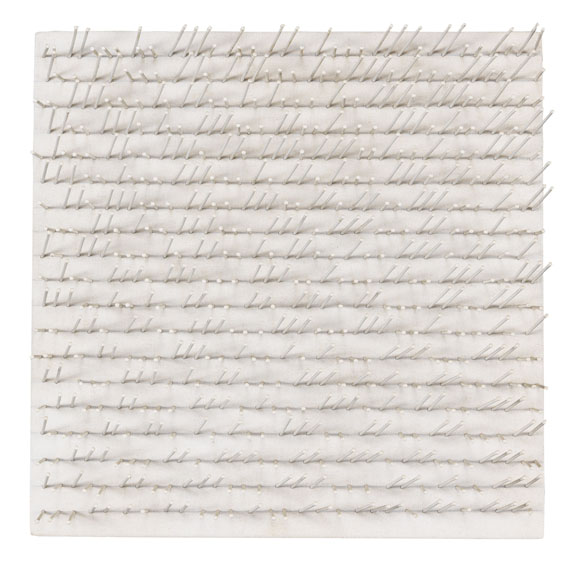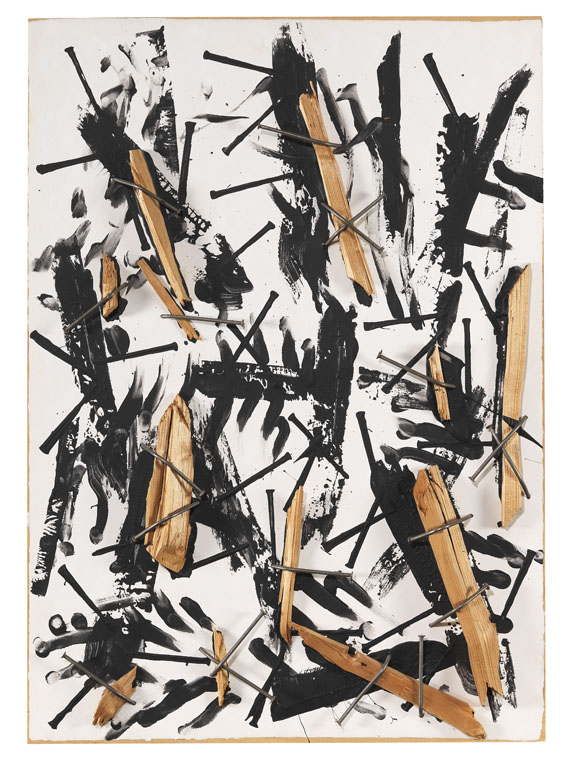Günther Uecker Follow Reihung signed and dedicated 'für Tünn und Eva von Uecker Günther' on the reverse pencil, nails and lacquer on wood 78.5 x 78.5 x 2 cm (30 7/8 x 30 7/8 x 0 3/4 in.) Executed in 1970, this work is accompanied by a photo certificate signed and dated by the artist.
Provenance Eva Konerding (gifted by the artist in 1970) Galerie M, Bochum Private Collection, Europe Dorotheum, Vienna, 25 November 2010, lot 1004 Acquired at the above sale by the present owner Catalogue Essay Coursing with sublime energy and executed in the artist’s seminal choice of medium, Reihung is exemplary of Günther Uecker’s defining technique and on-going fascination with the dimensional confines of the plane. 528 nails of identical length punctuate the white surface in a linear grid formation, infusing the composition with an organic vibrating rhythm. Uecker participated in the 35th Venice Biennale in 1970. At the time of the Biennale, Uecker and Tünn Konerding, Uecker's studio assistant, executed a selection of embossed prints; the present work was intended to form the relief from which a print would be embossed, however the print never came to fruition and Reihung was then gifted to Tünn's wife, Eva. Subsequently, another embossed print was included in the 1970 Biennale exhibition catalogue. Tünn designed Uecker’s Uecker-Zeitung in the 1970s; the publication circulated images of the artist’s progressive practice, making it visually accessible en masse within a politically charged post-war Germany. The present work gracefully encapsulates the artist's distinct style and lies at the height of Uecker’s artistic development. In the same year in which Reihung was executed, Uecker’s exhibition at the German Pavilion in 1970, together with Thomas Lenk Heinz Mack and Georg Karl Pfahler cemented his immovable reputation within the art world. The artist nailed into wooden panels which were then mounted to the outside pillar of the German pavilion portico, thus dismantling the neoclassical architecture, with all its fascist implications, into a reconfigured object. Uecker’s contribution received critical acclaim and the celebrated exhibition subsequently travelled to Zachęta National Gallery of Art in Warsaw in 1971, becoming the first West German exhibition of contemporary art to be shown in Poland. In Reihung the repetitively bent nails cast subtle shadows and manipulate light as it hits the picture plane, causing the work to vibrate with animated fervour as new perspectives are created. Whilst static, Uecker’s positioning of nails atop the intricately marked grid forces the viewer’s eye to rove over the surface of the work, creating a fluctuating sense of movement. The nail, a rigid, hard and threatening object, is subsumed into the visual motion of the surface, transforming the violent, sharp shape into a sensuously integrated form. Just as Lucio Fontana utilised a knife to slash the canvas and create dimensionality in his progressive works, so Uecker turns the picture into an ambiguous object. In Reihung the artist expertly confronts the viewer with the critical concerns of the avant-garde ZERO movement: the exploration of light, technology and the interrogation of the picture plane beyond the traditional two-dimensional confines of the canvas. Uecker’s choice of medium is weighted with cultural and historical significance; the systematic violence of the Second World War is evoked as is the religious violence of the Crucifixion. Conversely, Uecker’s interest in the ritualistic elements of religion, in particular the theology of Buddhism, Taoism, and Islam, is evident in Reihung, whereby the formulaic hammering of nails quintessentially encapsulates Uecker’s exploration of customs and ceremonial actions. Reflecting on the act which came to be his signature style, the artist noted, ‘Coming from East Germany, where I had been educated about the Russian Revolution of 1917, I was thinking about Vladimir Mayakovsky’s declaration that “poetry is made with a hammer”’ (Günther Uecker quoted in, Matthew Wilcox, 'Examining the scars of history with Günther Uecker', Apollo , 11 February 2017, online). Through hammering and penetrating the plane, Uecker metaphorically bores into the core of the matter, obliterating and destroying
Günther Uecker Follow Reihung signed and dedicated 'für Tünn und Eva von Uecker Günther' on the reverse pencil, nails and lacquer on wood 78.5 x 78.5 x 2 cm (30 7/8 x 30 7/8 x 0 3/4 in.) Executed in 1970, this work is accompanied by a photo certificate signed and dated by the artist.
Provenance Eva Konerding (gifted by the artist in 1970) Galerie M, Bochum Private Collection, Europe Dorotheum, Vienna, 25 November 2010, lot 1004 Acquired at the above sale by the present owner Catalogue Essay Coursing with sublime energy and executed in the artist’s seminal choice of medium, Reihung is exemplary of Günther Uecker’s defining technique and on-going fascination with the dimensional confines of the plane. 528 nails of identical length punctuate the white surface in a linear grid formation, infusing the composition with an organic vibrating rhythm. Uecker participated in the 35th Venice Biennale in 1970. At the time of the Biennale, Uecker and Tünn Konerding, Uecker's studio assistant, executed a selection of embossed prints; the present work was intended to form the relief from which a print would be embossed, however the print never came to fruition and Reihung was then gifted to Tünn's wife, Eva. Subsequently, another embossed print was included in the 1970 Biennale exhibition catalogue. Tünn designed Uecker’s Uecker-Zeitung in the 1970s; the publication circulated images of the artist’s progressive practice, making it visually accessible en masse within a politically charged post-war Germany. The present work gracefully encapsulates the artist's distinct style and lies at the height of Uecker’s artistic development. In the same year in which Reihung was executed, Uecker’s exhibition at the German Pavilion in 1970, together with Thomas Lenk Heinz Mack and Georg Karl Pfahler cemented his immovable reputation within the art world. The artist nailed into wooden panels which were then mounted to the outside pillar of the German pavilion portico, thus dismantling the neoclassical architecture, with all its fascist implications, into a reconfigured object. Uecker’s contribution received critical acclaim and the celebrated exhibition subsequently travelled to Zachęta National Gallery of Art in Warsaw in 1971, becoming the first West German exhibition of contemporary art to be shown in Poland. In Reihung the repetitively bent nails cast subtle shadows and manipulate light as it hits the picture plane, causing the work to vibrate with animated fervour as new perspectives are created. Whilst static, Uecker’s positioning of nails atop the intricately marked grid forces the viewer’s eye to rove over the surface of the work, creating a fluctuating sense of movement. The nail, a rigid, hard and threatening object, is subsumed into the visual motion of the surface, transforming the violent, sharp shape into a sensuously integrated form. Just as Lucio Fontana utilised a knife to slash the canvas and create dimensionality in his progressive works, so Uecker turns the picture into an ambiguous object. In Reihung the artist expertly confronts the viewer with the critical concerns of the avant-garde ZERO movement: the exploration of light, technology and the interrogation of the picture plane beyond the traditional two-dimensional confines of the canvas. Uecker’s choice of medium is weighted with cultural and historical significance; the systematic violence of the Second World War is evoked as is the religious violence of the Crucifixion. Conversely, Uecker’s interest in the ritualistic elements of religion, in particular the theology of Buddhism, Taoism, and Islam, is evident in Reihung, whereby the formulaic hammering of nails quintessentially encapsulates Uecker’s exploration of customs and ceremonial actions. Reflecting on the act which came to be his signature style, the artist noted, ‘Coming from East Germany, where I had been educated about the Russian Revolution of 1917, I was thinking about Vladimir Mayakovsky’s declaration that “poetry is made with a hammer”’ (Günther Uecker quoted in, Matthew Wilcox, 'Examining the scars of history with Günther Uecker', Apollo , 11 February 2017, online). Through hammering and penetrating the plane, Uecker metaphorically bores into the core of the matter, obliterating and destroying















Testen Sie LotSearch und seine Premium-Features 7 Tage - ohne Kosten!
Lassen Sie sich automatisch über neue Objekte in kommenden Auktionen benachrichtigen.
Suchauftrag anlegen